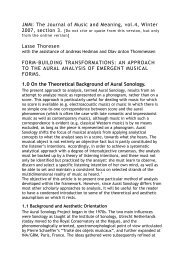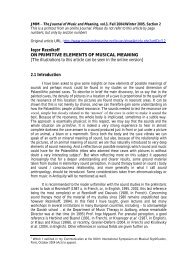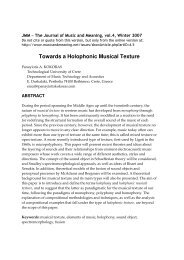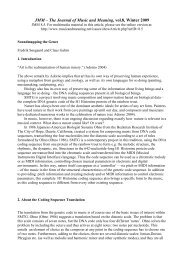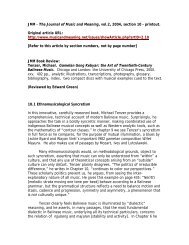The Use and Application of Proverbs in Basotho Accordion Music ...
The Use and Application of Proverbs in Basotho Accordion Music ...
The Use and Application of Proverbs in Basotho Accordion Music ...
Create successful ePaper yourself
Turn your PDF publications into a flip-book with our unique Google optimized e-Paper software.
Peer-Reviewed Paper JMM: <strong>The</strong> Journal <strong>of</strong> <strong>Music</strong> <strong>and</strong> Mean<strong>in</strong>g, vol. 11, 2012/2013<br />
cultures <strong>of</strong> <strong>Basotho</strong> people. Wells (1994:1-2) refers to this music as established canon rather<br />
than traditional music. He argues that tradition relates to someth<strong>in</strong>g static, while canon<br />
implies a created concept that provides people <strong>in</strong> the present with a constructed access to the<br />
past. He further notes that the music styles <strong>of</strong> the established canon tend to be associated with<br />
performance contexts that are thought to conta<strong>in</strong> values relat<strong>in</strong>g to past experiences.<br />
2.1 Traditional <strong>Music</strong><br />
<strong>Basotho</strong> music can be divided <strong>in</strong>to a variety <strong>of</strong> songs that relate to different occasions,<br />
<strong>in</strong>stitutions <strong>and</strong> groups <strong>of</strong> people from different levels <strong>of</strong> society. <strong>The</strong>se occasions <strong>in</strong>clude<br />
work songs <strong>and</strong> dance songs. Work songs specifically relate to the type <strong>of</strong> work done by the<br />
<strong>Basotho</strong> that identifies them as <strong>Basotho</strong>: communal actions such as hoe<strong>in</strong>g, tann<strong>in</strong>g ox hide or<br />
thresh<strong>in</strong>g corn for example (Guma 1967:103). <strong>Basotho</strong> have their own style <strong>of</strong> do<strong>in</strong>g th<strong>in</strong>gs.<br />
Where they work together as a team, for example, they s<strong>in</strong>g songs that are specific to the<br />
work done, help<strong>in</strong>g to make their work easier.<br />
<strong>The</strong> <strong>in</strong>itiation <strong>of</strong> <strong>Basotho</strong> males <strong>and</strong> females is an important <strong>in</strong>stitution that takes <strong>in</strong>to<br />
consideration the types <strong>of</strong> songs rendered, how they are sung, when they are sung <strong>and</strong> why<br />
they are sung (Moitse 1994: 45-79). Institutions vary accord<strong>in</strong>g to their status <strong>and</strong> functions;<br />
hence, each has its special songs <strong>and</strong> certa<strong>in</strong> roles it plays <strong>in</strong> the society. Moitse (1994)<br />
divides <strong>Basotho</strong> music <strong>in</strong>to three ma<strong>in</strong> <strong>in</strong>stitutions: div<strong>in</strong>ation, <strong>in</strong>itiation <strong>and</strong> birth. She further<br />
divides the <strong>in</strong>stitution <strong>of</strong> div<strong>in</strong>ation <strong>in</strong>to two sub-topics: ancestral worship that deals with<br />
<strong>Basotho</strong> religious beliefs <strong>in</strong> ancestors, <strong>and</strong> traditional heal<strong>in</strong>g that refers to the practice <strong>of</strong><br />
traditional medic<strong>in</strong>e. <strong>The</strong> <strong>in</strong>stitution <strong>of</strong> <strong>in</strong>itiation subdivides <strong>in</strong>to male <strong>and</strong> female <strong>in</strong>itiation,<br />
under which dist<strong>in</strong>ction she discusses the music <strong>and</strong> other relevant activities. Moitse also<br />
relates the musical performances <strong>and</strong> other activities performed dur<strong>in</strong>g the celebrations<br />
surround<strong>in</strong>g the <strong>in</strong>stitution <strong>of</strong> birth.<br />
With regard to age <strong>and</strong> gender aspects, (Wells 1994: 2) makes three ma<strong>in</strong> divisions<br />
between men’s, women’s <strong>and</strong> children’s songs. His group<strong>in</strong>g takes <strong>in</strong>to account both age <strong>and</strong><br />
gender aspects. For <strong>in</strong>stance, certa<strong>in</strong> songs among the <strong>Basotho</strong> are sung by young males <strong>and</strong><br />
females who are ripe for marriage. Examples <strong>in</strong> this case are drawn from the selia-lia <strong>and</strong><br />
sephumula games. <strong>The</strong> participants who s<strong>in</strong>g <strong>in</strong> these games are young males <strong>and</strong> females. In<br />
these games, accompanied by s<strong>in</strong>g<strong>in</strong>g, they are given a chance to choose their future husb<strong>and</strong>s<br />
<strong>and</strong> wives. Another example is that <strong>of</strong> mokorotlo-war song, usually sung by male adults <strong>and</strong><br />
50




